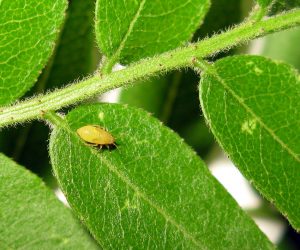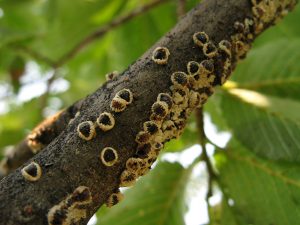In this Issue:
- Powdery mildew: Monitor plants for white mycelium
- Bronze birch borer: Adults laying eggs now through mid-June
- Honeylocust and Sycamore plant bugs: Active now, but treatment usually not warranted
- Root weevils: Feeding damage visible now
- Scales: Active now or in the next few weeks, are euonymus scale, European elm scale, lecanium scale, and black pineleaf scale
- Pine pitch mass borer: Apply trunk spray now
DECIDUOUS TREES
Powdery Mildew
Monitor plants for new infections

Powdery mildew is starting to show up on roses, maples, ornamental pears, honeysuckle, lilac, crabapple, and other plants. It is important to monitor your own plants to catch it early. Check the undersides of leaves that are lowest on the plant, looking for white, powdery spots.
Powdery mildew is a fungal disease that prevents leaves from photosynthesizing to their fullest ability, resulting in stunted leaf growth, chlorosis or scorching, and leaf drop. In late summer, the fungus produces black fruiting bodies called chasmothecia which allow the fungus to survive the winter on bark or fallen leaves.
Free water (rain) does not spread powdery mildew. Instead, it thrives in the high humidity of the plant canopy, which may increase after rainfalls or overhead irrigation. In Utah landscapes, powdery mildew is found more on crowded or shaded plantings.
Treatment
To lessen infections, prune out or pick off localized infections, avoid overhead irrigation, improve air circulation between and within plants, and rake fallen leave in the fall.
- Residential options: Organic options are horticultural oil (0.5%), Serenade, potassium bicarbonate (Bicarb, Kaligreen), or neem oil. Organic products must be applied every 5 to 7 days. Conventional options include Spectracide Immunox, Monterey Garden Fungicide, or chlorothalonil, and can be applied twice, spaced 14 days apart.
- Commercial options: There are many fungicides for ornamental application against powdery mildew, including AmTide, Banner Maxx, Bayleton, Eagle, Heritage, Pageant, Rally, Trinity
Bronze Birch Borer
Adult egg-laying has begun in the warmer areas of the Wasatch Front, and will continue until mid-June

Bronze birch borer is a flatheaded-type borer that attacks European and Asian species of birch. Trees that are infested will have D-shaped exit holes, and a “lumpy” appearance to the bark, where the feeding galleries occur. Repeated attacks will cause tree to slowly die back.
Treatment
- Residential: Keep trees healthy with optimal water and nutrients (including iron). We recommend hiring a professional applicator that can reach the entire trunk and main limbs of a tall tree. Otherwise, options for home application include Hi Yield Permethrin, GardenTech Sevin, or Spectracide Triazicide.
- Commercial: Imidacloprid can be used as a soil injection to kill larvae within the tree, but ideally should be applied in early spring or in fall, as the tree needs time for uptake. Studies have shown, however, that soil applications applied in late spring will also kill a certain amount of larvae within the tree. Trunk sprays include permethrin, bifenthrin, or carbaryl.
Honeylocust and Sycamore Plant Bug
Active now, but treatment usually not warranted

Plant bugs on honeylocust and sycamore are building in population size now. They can be detected by the leaf symptoms, or by shaking several branches over paper or a cloth tray.
Plant bugs overwinter as eggs that hatch into nymphs during leaf expansion. The honeylocust plant bug has just one generation per year, so the nymphs and adults are only around for about 6 to 8 weeks. The sycamore plant bug has many generations per season, and can thus cause damage throughout the season.
Adults and nymph plant bugs feed with piercing-sucking mouthparts, where they they inject a toxin into the leaves that kills the tissue, causing chlorotic (yellow) and necrotic (brown) stippling, and ragged leaves. Leaves also become distorted, discolored, and dwarfed.

Treatment
If nymphs (insects without wings) and feeding damage is found, a strong stream of water on the plant leaves will knock them off, and because they are flightless, the nymphs will have a hard time crawling back to the leaves.
If an application is warranted, a pyrethroid (conventional) or insecticidal soap or horticultural oil (both organic) are effective.
Root Weevils

The characteristic leaf-notched feeding by adult weevils is showing up on a variety of hosts including dogwood and lilac. Most weevils that feed on woody ornamentals overwinter as larvae in the soil, pupate in spring, and emerge as adults in June. The adults feed on leaves, where the damage is more aesthetic, while the larvae cause greater damage by feeding on fine roots.
The two most common root weevils in Utah are the strawberry root weevil (Otiorhynchus ovatus) and the lilac root weevil (O. meridionalis).
Root weevils adult and larval feeding are usually not a concern on mature plants. But where populations are high or where young plants are affected, control may be warranted, targeting the larvae.
Treatment
Two options are predatory nematodes (soil must be kept moist), or imidacloprid soil drench.
European Elm Scale and European Fruit Lecanium Scale
Lecanium scale active June 6; Elm scale crawlers active June 16

Crawlers of both the European elm and lecanium scale will begin activity along the Wasatch Front area in the next few weeks. These pests are soft scales that produce honeydew as they feed. This sticky material drips down onto cars, people, and other plants, which can be a nuisance. Branches and bark covered in black sooty mold (that thrives on the honeydew) is a sure sign of a heavy infestation. In addition, branch dieback, stunting, loss of tree vigor, and defoliation also occur.
Females of both species lay hundreds of eggs in early summer, and crawlers hatch beginning in early to mid July, continuing for approximately a month. Crawlers move to the underside of leaves and succulent twigs to feed for the summer, and then migrate back to twig crevices for the remainder of their lives. There is a single generation per year.

Scale insects are difficult to treat, but there are a few windows of opportunity for control. Dormant oil sprays in spring will smother many overwintering soft scales, but for severe infestations, it is not a stand-alone treatment. Targeting the crawler stage is most effective because nymphs are more susceptible to treatment than adults.
Treatment
- Residential: Horticultural oil (1%; in temps below 85°F on non-drought-stressed trees) or insecticidal soap are both organic options
- Commercial: horticultural oil or insecticidal soap, azadirachtin, carbaryl, synthetic pyrethroids, malathion, imidacloprid, dinotefuran
Euonymus Scale
Crawlers have started emergence and will continue through mid-June in Wasatch Front area

Euonymus scale is an armored scale that can occur in very high numbers on wintercreeper. Leaves and twigs can be covered in what looks like immobile whiteflies, causing defoliation and decline.
Treatment
- Residential: Organic options are horticultural oil (1%) or insecticidal soap, and conventional options are GardenTech Sevin (zeta-cypermethrin), or BioAdvanced Insect Killer (cyfluthrin).
- Commercial: Pyrethroids, malathion, imidacloprid (fall application)
CONIFERS
Black Pineleaf Scale
Crawlers begin activity June 16 – 22 along Wasatch Front

Black pineleaf scale affects Austrian, Scotch, and mugo pines. If a treatment by foliar application (instead of soil-applied systemic) is necessary, it should be applied by June 16 (warmer areas of Wasatch Front) or June 22 (cooler areas). By mid to late July, crawlers will have settled to immobility for the remainder of their lives, and treatment will be too late.
The black pineleaf scale is an armored scale, concealing its body under a thick waxy covering. This scale feeds on nutrients and contents of mesophyll cells, and unlike soft scales, does not produce honeydew.
Where it feeds, needles becomes yellow with localized necrosis (death). Under heavy and prolonged infestations, needles that are normally retained for 5 years will drop in 1 to 2 years. New needles are sparse, stunted, and chlorotic. Branches die back and the tree may eventually be killed.
In light infestations, two sprays of horticultural oil (1-2%), one week apart, could be all that is needed.
Treatment
Trees under stress from drought conditions or nutrient deficiencies are more susceptible to infestation, so remedy these conditions. A systemic insecticide application can be highly effective, but is more expensive than foliar applications. The systemic can be applied in spring, while the foliar application must be timed with crawler emergence.
- Residential: Organic options are horticultural oil (1%) or insecticidal soap, and conventional options are GardenTech Sevin (zeta-cypermethrin), or BioAdvanced Insect Killer (cyfluthrin).
- Commercial: carbaryl, cyfluthrin (Tempo), Movento, dinotefuran (Safari) as a soil injection
Pine Pitch Mass Borer
Treat trunks of pines now
The Sequoia pitch moth (Synanthedon sequoiae) is a clearwing moth whose larvae feed on the outer and inner bark of pine trees. Their feeding stimulates the tree to produce copious sap that forms large, drippy masses on the trunk. The larvae will also feed within the mass of pitch and if you remove the glob at the right time, you will often find a larva inside or close to the trunk.
From May through August, adult moths lay eggs on bark, often preferring pruning or other wounds, branch collars, or existing pitch masses. When the eggs hatch, the larvae bore through the bark and create meandering tunnels in the cambium, or may bore into the sapwood. The feeding is usually localized around the pitch mass, and sometimes, the larvae will exit the wood and feed on the pitch.
Smaller trees are at greatest risk of being affected by pitch mass borers. Larger, healthy trees can withstand attack.
Keep in mind that after the moths exit the trees, the pitch mass will remain on the trunk, possibly for several years, unless they are removed by hand.
Treatment
Management should focus on keeping trees healthy. Avoid pruning in July when moths are laying eggs. Manually remove existing pitch masses to prevent further egg-laying or to kill larvae inside. If a spray is warranted on larger trees, it should be applied by a professional.
- Commercial: permethrin or bifenthrin (trunk sprays); start application in mid May, so that trunks are protected through early August



